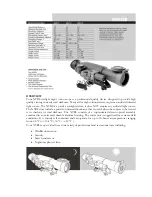
High-Latitude Tripod Leg
o
56° to 66° uses High-Latitude hole.
o
44° to 55° uses Alternate hole.
Thread the appropriate leg into the required hole to a firm feel only.
6. A small thumbscrew (6, Fig. 15) is attached to both the standard and high-latitude tripod legs.
Loosening the thumbscrew allows the outer section of the leg to slide over the inner section,
so that the length of the leg can be extended. If using the standard tripod leg, extend the leg
so that the center of the thumbscrew-head is lined up with the latitude of the observing
location on the scale. Then retighten the thumbscrew to a firm feel. (If using the high-latitude
tripod leg, final adjustment of the leg extension is completed in step 9.)
Example:
The latitude of New York City is 41°. The tripod leg should be extended so that the
center of the thumbscrew is set next to the 41° reading on the scale.
CAUTION: Polar alignment at latitudes between 22° and 30° requires that the
optional #1422 Low-Latitude Balance Weight (8, Fig. 15) be attached to the
adjustable leg to stabilize the ETX-90EC for observing.
NOTE: With the standard tripod leg threaded into the appropriate hole in the drive
base, the latitude scale may be at an inconvenient position for reading (e.g., the scale
may be facing the drive base). This situation can be remedied by unthreading the leg,
removing the thumbscrew, rotating the inner leg 180°, then reinserting the
thumbscrew. The scale should now be readable when threaded back into the
telescope base.
7. Loosen the vertical and horizontal locks (6 and 10, Fig. 1) and rotate the telescope so that it is
oriented as shown in Fig. 15. Tighten the vertical and horizontal locks. In this orientation the
telescope's optical tube is lined up parallel to the tripod's adjustable leg.
8. Note the dotted line and arrow extending from the telescope tube in Fig. 15. This line defines
the telescope's polar axis. Lift the entire telescope, including tripod, and place the telescope
on a firm and level surface so that this axis is pointing due North. For example, if the location
of Polaris, the North Star, is known then point the telescope directly at Polaris.
9. If using the high-latitude tripod leg in the northern hemisphere, extend the leg until the
telescope's polar axis points to Polaris, or due North, an alignment obtained by sighting along
the telescope tube with the telescope oriented as shown in Fig. 15.
10.
NOTE: Observer's located in the earth's
southern hemisphere (e.g., South America,
Australia, etc.) should point the telescope's
polar axis due South.
11. With the telescope now polar-aligned the
table
tripod should not be moved, or else polar
alignment will be lost. Motions of the
telescope (e.g., to locate and/or track
objects) should be effected only (a) by
loosening the locks (6 and 10, Fig. 1),
which permits the optical tube to be moved
freely within the telescope mounting, or (b)
more
generally, with the locks in their "locked"
positions, by using the arrow keys of the
Electronic Controller.
Fig. 15: Polar Alignment using the #880 Table
Tripod. (1) Standard Tripod Leg with Latitude Scale;
(2) High Latitude Hole; (3) Alternate Hole; (4) Fixed
Tripod Legs; (5) Declination Pointer; (6)
Thumbscrew; (7) R.A. Scale Pointer; (8) optional
#1422 Low-Latitude Balance Weight.




























